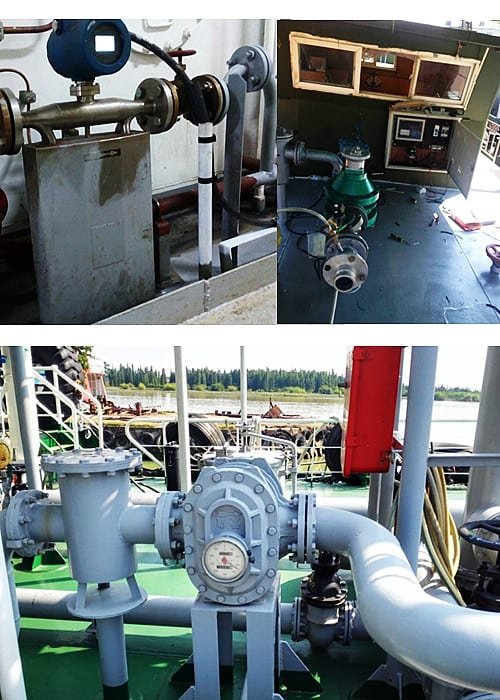Fuel Flow Meter for Boat refers to a flow meter dedicated to measuring marine fuel. There are many types of marine fuel oil. Mainly include light diesel, heavy diesel, fuel oil, and residual fuel oil. Specifically include: 0# diesel, -10# diesel, 20# heavy diesel, 4# fuel oil, 120# fuel oil, 180# fuel oil, 380# fuel oil, etc.
Therefore, select the appropriate flow meter to monitor the fuel flow and manage the fuel filling or consumption. This is important for controlling fuel costs.

At present, ships are in the process of refueling, especially for heavy fuel oil. The traditional method of measuring tank capacity is used to calculate the quantity of fuel oil. This method is very cumbersome and the accuracy is not high. And if the fuel flow meter is used, the above shortcomings can be well overcome.
There are many kinds of flowmeters on the market now, which makes it difficult for designers to choose their models. Different types of flowmeters have different characteristics. When choosing a suitable flowmeter according to the characteristics of the ship’s fuel oil, good test results can be achieved.
Selection of Fuel Flow Meter for Boat
- Fuel performance
Fuel oil is a mixed liquid whose viscosity changes greatly with temperature, and there are many impurities in it.
Generally, when fuel oil is installed, it is realized through a closed delivery pipeline. The type of fuel generally installed on real ships is F120, and its density at 20°C is 981.6㎏/m3.
Combine these properties of fuel. Compared with the performance analysis of various flowmeters introduced above. Although volumetric flowmeters and turbine flowmeters have high accuracy, they have high requirements for fluid cleanliness. Electromagnetic flowmeters are only suitable for conductive liquids, so they are not applicable here. Coriolis mass flow meters can be used, but the cost is higher. Differential pressure flow meters are also optional. However, it is necessary to cooperate with a differential pressure transmitter for flow measurement and control.
- Working conditions of fuel flow meter
When the fuel flow meter is working, the temperature of the fuel passing through the flow meter is about 40°C. The agreed pump speed is 12m3/h, and the agreed maximum pump pressure is 0.4MPa. The amount of fuel added this time is 240t.
According to these few data, in the further flowmeter selection. Float flow meters should also be excluded. According to the characteristics of the float flowmeter, set up and measure the small flow of fluid. However, when the fuel is installed, the quantity is too large and it is not suitable for selection.
The vortex flowmeter works by using the principle of fluid oscillation. Avoid strong vibration when installing the sensor. However, according to the working conditions of the ship, the vibration and noise are very large. If a vortex flowmeter is selected, the measurement accuracy will be greatly affected in actual use.
It can be generally determined that both the differential pressure flowmeter and the ultrasonic flowmeter meet the requirements. Also, gear flow meters, mass flow meters, etc. These types of flow meters have a wide range of applications and are suitable for a variety of liquids.
Extended Reading: Guide and Selection for Diesel Fuel Flow Meters
Featured Fuel Flow Meter for Boat
Marine Fuel Mass Flow Meter (MFM)
Mass flow meter directly measures the mass flow of the medium passing through the flow meter. It can also measure the density, temperature and viscosity of the medium
The Singapore Standards Committee issued the new Singapore Standard SS6481-Marine Fuel Mass Flow Meter (MFM) Usage Guidelines. To support the shipping industry’s formal implementation of the “Sulfur Restriction Order” from January 1, 2020 to improve the low-sulfur fuel system. And Guidelines for improving and regulating MFM fuel filling behavior.
Regarding Singapore’s new SS6481-Marine Fuel Mass Flow Meter (MFM) Code of Conduct. The Director of the Technical Committee for Bunkering (Chairman, Technical Committee for Bunkering) Seah Khen Hee pointed out——
“Metrology and system integrity are the dual foundations of SS648. It is the foundation of MFM system approval and fuel metering and handover procedures.”
Extended reading:
Singapore launches enhanced mass-flow metering standard
Sino-Inst, Manufacuturer for Fuel Flow Meter for Boat. For example: crude oil flowmeter, diesel flowmeter, gasoline flowmeter.
Sino-Inst’s Fuel Flow Meter for Boat, made in China, Having good Quality, With better price. Our flow measurement instruments are widely used in China, India, Pakistan, US, and other countries.
Request a Quote
Wu Peng, born in 1980, is a highly respected and accomplished male engineer with extensive experience in the field of automation. With over 20 years of industry experience, Wu has made significant contributions to both academia and engineering projects.
Throughout his career, Wu Peng has participated in numerous national and international engineering projects. Some of his most notable projects include the development of an intelligent control system for oil refineries, the design of a cutting-edge distributed control system for petrochemical plants, and the optimization of control algorithms for natural gas pipelines.